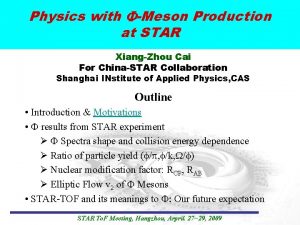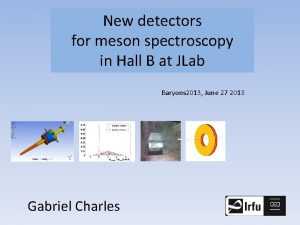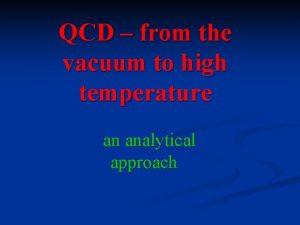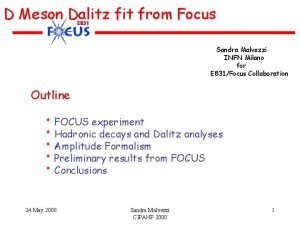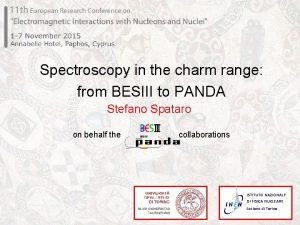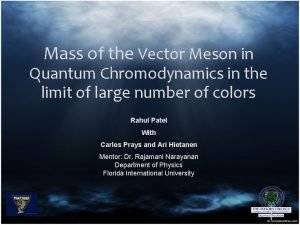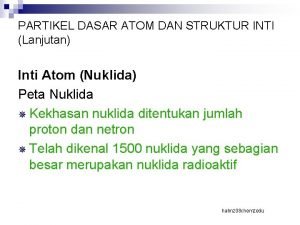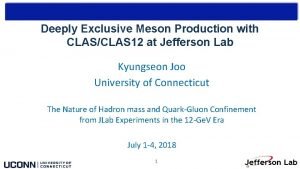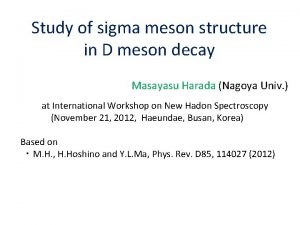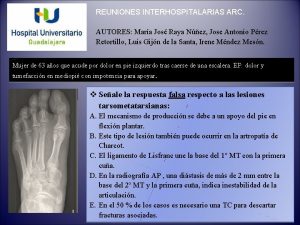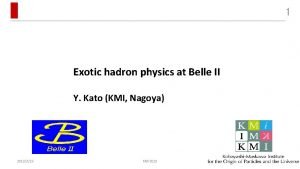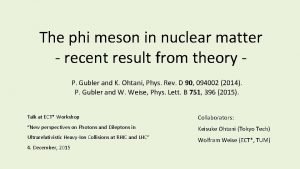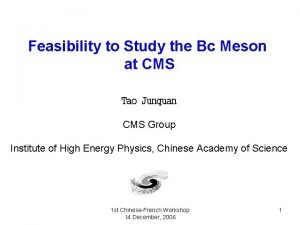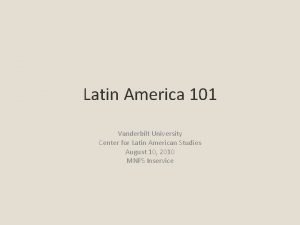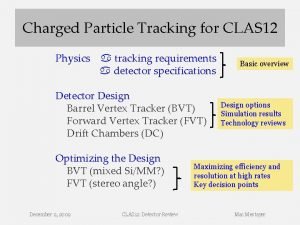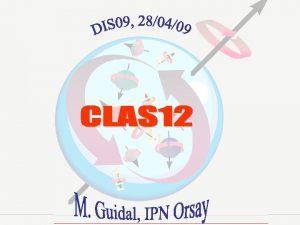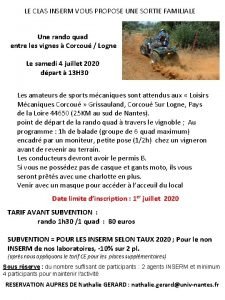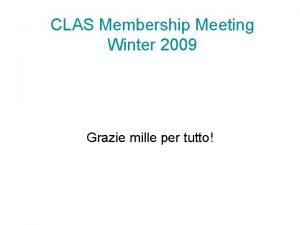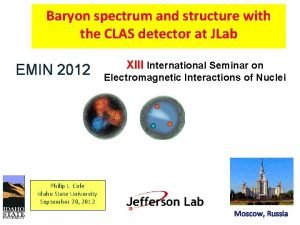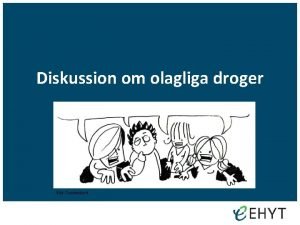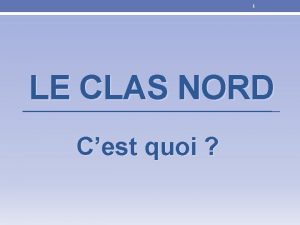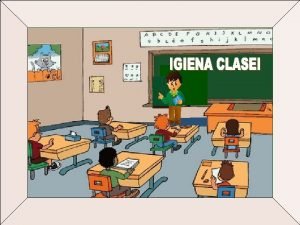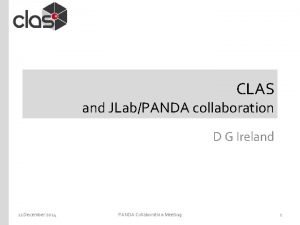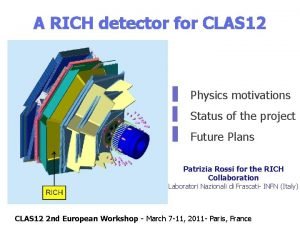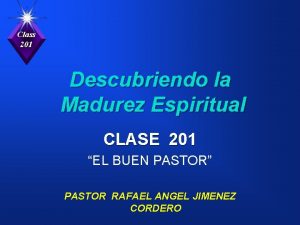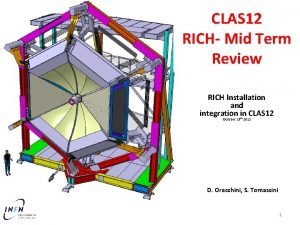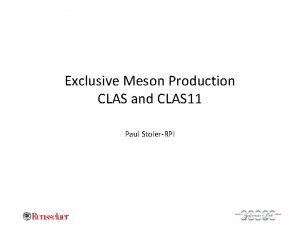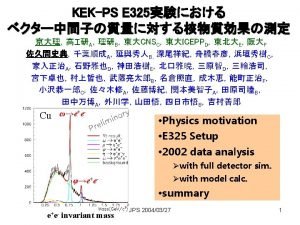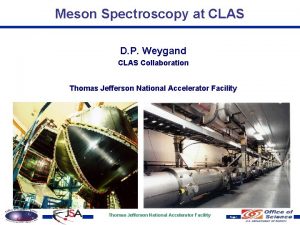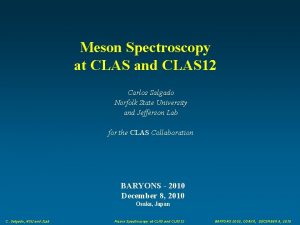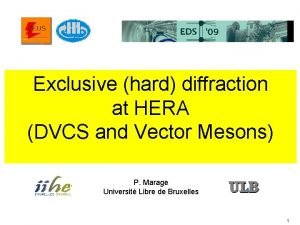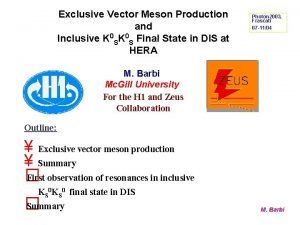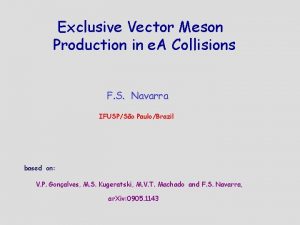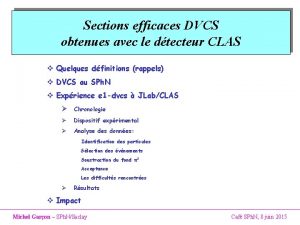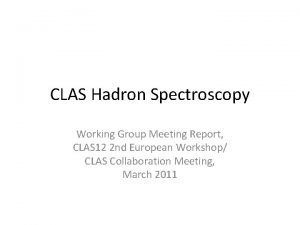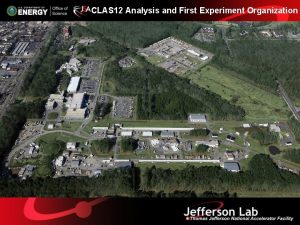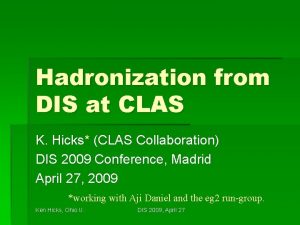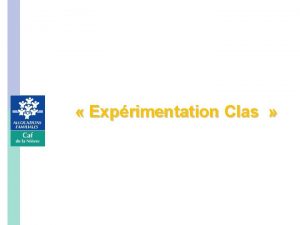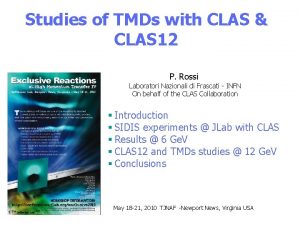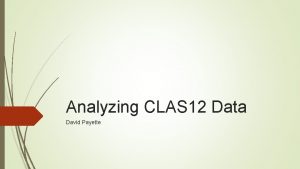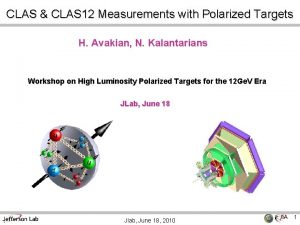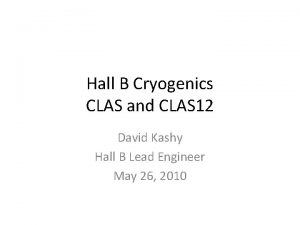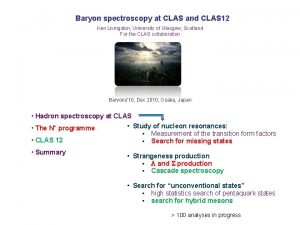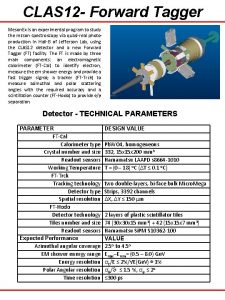DVCS Exclusive Vector meson Largex PDFs The CLAS






































- Slides: 38


DVCS Exclusive Vector meson Large-x PDFs The CLAS 12 detector } 3 particular Examples among many others

DVCS Exclusive Vector meson Large-x PDFs The CLAS 12 detector

GPDs DVCS Bethe-Heitler

GPDs DVCS Bethe-Heitler

Proton-DVCS BSAs with CLAS 12 ep ep + - A= + + - = 2 LU~sin {F 1 H+. . }d Kinematically suppressed Sensitivity to H(x, x, t)

CLAS 12 ep DVCS/BH Longitudinal Target Asymmetry ep Longitudinally polarized target ~ 1+F 2)H. . . }d UL~sin Im{F 1 H+x(F Sensitivity ~ to H(ξ, t)

en 0 because F 1(t) is small JLab Hall A Collaboration, PRL 99: 242501, 2007 en 0 because of cancelation of u and d quarks n-DVCS gives access to the least known and constrained GPD, E

DVCS BSA: sensitivity to Ju, Jd DVCS on the neutron Hall A 6 Ge. V Ju=. 3, Jd=. 1 Ju=. 8, Jd=. 1 Ju=. 5, Jd=. 1 Ju=. 3, Jd=. 8 Ju=. 3, Jd=-. 5 n-DVCS BSA is: • very sensitive to Ju, Jd • can be as strong as for the proton According to the kinematics and Ju, Jd Ee = 11 Ge. V f= 60° x. B = 0. 17 Q 2 = 2 Ge. V 2 t = -0. 4 Ge. V 2

DVCS BSA: sensitivity to Ju, d DVCS on the proton Ju=. 3, Jd=. 1 Ju=. 8, Jd=. 1 Ju=. 5, Jd=. 1 Ju=. 3, Jd=. 8 Ju=. 3, Jd=-. 5 f= 60° x. B = 0. 2 Q 2 = 2 Ge. V 2 t = -0. 2 Ge. V 2 Ee = 11 Ge. V

n. DVCS with CLAS 12 ~ 80% of neutrons from n-DVCS have q>40° → neutrons detector for central part of CLAS 12 (CD) <pn>~ 0. 4 Ge. V/c CD Detected in CLAS 12 (FD) ed→e’n (p) PID (n or ? ) + angles to identify final state CTOF CND Central Tracker Not detected Detected in FEC, IC Technical challenges : • available room very small (thickness cm) → no room for light guides → need a compact read-out system • strong magnetic field (5 T) → photodetectors insensitive to the magnetic field (Si. PMs or Microchannel PMTs) • resolution on time-of-flight ~ 150 ps to distinguish neutrons from photons

DVCS Exclusive Vector meson Large-x PDFs The CLAS 12 detector

Longitudinal cross section s. L ( *Lp pr. L 0) C. Hadjidakis et al. , Phys. Lett. B 605: 256, 2005 (r 0@4. 2 Ge. V) S. Morrow et al. , Eur. Phys. J. A 39: 5, 2009 (r 0@5. 75 Ge. V)

ep epr 0 EPJA 09 VGG GPD model GK GPD model

VGG + “meson exchange” VGG w/o “meson exchange” (VGG) “meson exchange”

kperp corr. (+ “meson exchange”) Leading twist handbag


HERMES CLAS

ds/dt ( *p p r 0) b constant as Q 2 increases ?

r w f

DVCS Exclusive Vector meson Large-x PDFs The CLAS 12 detector

The Problem: nuclear binding uncertainties prevent us from knowing F 2 n and d/u(x 1) The Solution: spectator proton tagging select low-momentum part of d wave function and tag motion of struck neutron kinematically corrected W spectrum on n in d F 2 n extracted from deuteron data Bo. Nu. S W spectrum on d (Experiment e 8 w/ CLAS) Analysis underway… results in late 2009 How? Slow proton recoil detector (radial TPC) F 2 n/F 2 p W > 1. 9 Ge. V Q 2 > 1 Ge. V 2 W > 1. 6 Ge. V Q 2 > 2 Ge. V 2

CLAS 12 Valence Quark Distribution d/u There is large uncertainty in the ratio d/u of down and up quark distributions at large x, due to large effects of nuclear wave function. This can be significantly improved by performing the measurement at kinematics where nuclear effects are under control. en(ps) → eps. X Measure spectator proton to tag scattering of “free” neutron with small FSI.

CLAS 12 Valence spin structure function Existing Data from CLAS Isgur, PRD 59, 034013 (2003) W > 2; Q 2 > 1 Close and Melnitchouk, PRC 68, 035210 (2003) } Proton Deuteron

CLAS 12 Proton Valence spin structure function W > 2; Q 2 > 1 Deuteron Accurate measurement of Q 2 dependence is key for extraction of ΔG(x)

Proposed Initial Physics Program in Hall B q GPD’s and 3 D-Imaging of the Nucleon § Deeply Virtual Compton Scattering - DVCS § Deeply Virtual meson Production at low/high t q Valence Quark Distributions § u- and d-Quark Spin Distributions in Proton and Neutron § Neutron Structure Function F 2 n(x, Q 2) , d/u § TMD Quark Distribution Functions in SIDIS q Form Factors and Resonance Excitations § The Magnetic Structure of the Neutron – GMn § N* Transition Form Factors at high Q 2 q Hadrons in the Nuclear Medium § Space-Time Characteristics of Quark Hadronization § Color Transparency § Short Distance Dynamics of Light Nuclei 13 CLAS 12 already approved experiments (and 7 LOIs) corresponding to about 5 years of scheduled beam operation.

DVCS Exclusive Vector meson Large-x PDFs The CLAS 12 detector

Jefferson Lab Today Hall B Large acceptance spectrometer electron/photon beams A B C

CLAS 12 Central Detector Forward Detector

CLAS 12 Beamline equipment Single sector (exploded view)

CLAS 12 Central Detector • Superconducting 5 T Solenoid Magnet, 78 cm ø warm bore. • Central Time-of-Flight array (CTOF) ΔT < 60 psec • Silicon Vertex Tracker 31

CLAS 12 – Solenoid, Torus Magnets & Tracking Chambers The B-field transverse to the particle trajectory is approximately matched to the average particle momentum. DC’s IC DC: 36 layers iπ 3 regions, 6 sectors, 24, 000 sense wires. IC: Calorimeter, 424 Pb. WO crystals

CLAS 12 – PID & Calorimetry FTOF Forward Carriage LTCC EC PCAL FTOF: Timing resolution ΔT<80 ps PCAL/EC: Electron, photon, neutron detection, high energy γ/π0 reconstruction. LTCC: Electron & pion separation. RICH: Needed for better Kaon id in some sectors.

CLAS 12 Forward Detector Design Parameters (Base equipment) Angular range Charged Particles Photons Resolution p/p (%) (mr) Central Detector Photon detection Energy (Me. V) (mr) Neutron detection Neff Particle ID e/ /p /K K/p 0 Forward Detector Central Detector 50 – 400 20 – 400 – 1350 N/A < 1 @ 5 Ge. V/c < 0. 5 < 3 @ 0. 5 Ge. V/c < 10 < 6 >150 4 (1 Ge. V) N/A 0. 1 – 0. 6 0. 10 Full range < 4 Ge. V/c Full range N/A ≤ 1. 2 Ge. V/c ≤ 0. 65 Ge. V/c ≤ 0. 90 Ge. V/c N/A

CLAS 12 in Hall B Moller polarimeter Photon Energy tagging system Polarized targets Goniometer/polarized photons Pair spectrometer Beam monitors

Future Upgrades to CLAS 12 Base Equipment • Micromegas (Saclay) – Detailed simulation and track reconstruction – Prototypes being tested, engineering design underway – Review will take place in May 2009 • RICH Detector (INFN, Argonne, UK ) – Conceptual design with detailed simulations – PAC 34 approved 3 major experiments requiring RICH • Neutron detector (IN 2 P 3/INFN) – Detailed simulations, components being studied – PAC 34 gave high rating to the science presented in LOI • HD-ice Polarized target (JLab/INFN) – Laboratory facility being designed • Quasi real photon tagging facility (INFN, UK) – Feasibility study

CLAS 12 Institutions Institution Focus Area Arizona State University (US) Beamline, Tagging System Argonne National Laboratory (US) Cerenkov Counter California State University (US) Cerenkov Counters Catholic University of America (US) Software College of William & Mary (US) Calorimetry, Magnet Mapping Edinburgh University (UK) Software Fairfield University (US) Polarized Target Florida International University, Miami (US) Beamline/Moller polarimeter Glasgow University (UK) Central Detector, DAQ, Forward Tagger, RICH Grenoble University/IN 2 P 3 (France) Central Detector Idaho State University (US) Drift chambers INFN –University Bari (Italy) tbd, interest in RICH INFN –University Catania (Italy) tbd INFN – Frascati and Fermi Center (Italy) Central Neutron Detector+ interest show in RICH INFN –University Ferrara (Italy) (will join in 2010) tbd, interest in RICH INFN – University Genoa (Italy) Central Neutron Detector+ interest in Forward Tagger INFN – ISS/Rome 1 (Italy) tbd, interest in RICH INFN – University of Rome Tor Vergata (Italy) Central Neutron Detector+ HD target Institute of Theoretical and Experimental Physics (Russia) SC. Magnets, Simulations James Madison University (US) Calorimetry Kyungpook National University (Republic of Korea) CD TOF Los Alamos National Laboratory (US) Silicon Tracker Moscow State University, Skobeltsin Institute for Nuclear Physics (Russia) Software, SVT Moscow State University (High Energy Physics) (Russia) Silicon Tracker Norfolk State University (US) Preshower Calorimeter Ohio University (US) Preshower Calorimeter Orsay University/IN 2 P 3 (France) Central Neutron Detector Old Dominion University (US) Drift Chambers Renselear Polytechnic Institute (US) Cerenkov Counters CEA Saclay (France) Central Tracker, Reconstruction software Temple University, Philadelphia (US) Cerenkov Counters Thomas Jefferson National Accelerator Facility (US) Project coordination & oversight University of Connecticut (US) Cerenkov Counters University of New Hampshire (US) Central Tracker, Offline Software University of Richmond (US) Offline Software University of South Carolina (US) Forward TOF University of Virginia (US) Beamline/Polarized Targets Yerevan Physics Institute (Armenia) Calorimetry

12 Ge. V Schedule • Oct ‘ 13: Hall A commissioning start • Apr ‘ 14: Hall D commissioning start • Oct ‘ 14: Hall B & C commissioning start
 Mutually exclusive vs non mutually exclusive
Mutually exclusive vs non mutually exclusive K star meson
K star meson Meson
Meson Meson valves
Meson valves Sandra malvezzi
Sandra malvezzi Ombesito
Ombesito Meson
Meson Partikel meson
Partikel meson Clasclas
Clasclas Lean meson
Lean meson Irene mendez meson
Irene mendez meson Lucas 10 18
Lucas 10 18 B meson decay
B meson decay Phi meson
Phi meson Bc meson
Bc meson Define position vector.
Define position vector. Formula for partitioning a line segment
Formula for partitioning a line segment Suma de dos vectores
Suma de dos vectores Resolution of vectors
Resolution of vectors Classdoje
Classdoje Clas vanderbilt
Clas vanderbilt Clas
Clas Clas
Clas Clas standards 5-8
Clas standards 5-8 Clas inserm
Clas inserm Good afternoon class
Good afternoon class Uf premed advising
Uf premed advising Grazie membership
Grazie membership Clas
Clas Clas rehnberg
Clas rehnberg Clas rehnberg
Clas rehnberg Clas nord
Clas nord Contoh class diagram
Contoh class diagram Curatenia in salile de clasa
Curatenia in salile de clasa Clas collaboration meeting
Clas collaboration meeting Clas
Clas Clase 201 descubriendo mi madurez espiritual pdf
Clase 201 descubriendo mi madurez espiritual pdf Lish3
Lish3 Clas collaboration meeting
Clas collaboration meeting

